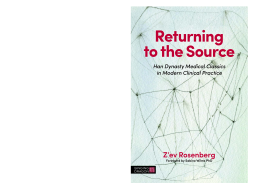
Additional Information
Book Details
Abstract
Chinese Medicine constantly refers back to its sources in order to initiate the new. Its source code is in the Han Dynasty medical classics, and in this handbook esteemed practitioner and educator Professor Z'ev Rosenberg shares the knowledge from his study of these classic texts and his experiences treating difficult cases.
In the tradition of the scholar-physician commentaries, Z'ev Rosenberg comments on the Simple Questions that introduce the core principles of the Inner Canon; explaining how these inform his methodology of diagnosis and advising on how biomedical diseases can be retranslated into sophisticated Chinese medical diagnoses including patterns of differentiation, sequential diagnosis, synchronicity, season, climate and environment. He discusses how Chinese medicine can use unique diagnostic parameters to rebalance the landscape and chronobiology of the body and address the greatest clinical challenges of our time, including the contemporary epidemic of autoimmune disorders.
An invaluable encouragement to budding practitioners and seasoned experts alike.
Arnaud Versluys, PhD, MD (China), LAc, Director, Institute of Classics in East Asian Medicine
Z'ev Rosenberg LAc is Chair Emeritus of Pacific College of Oriental Medicine, San Diego. In private practice since 1983, he is recognised as one of the first generation of practitioners of TCM in the US.
Spiced up liberally with enlightening quotations from Chinese medical literature ... This book is a powerful distillation of the key messages from the ancient Chinese medical classics, as relevant today as they were two thousand years ago.
from the foreword, by Dr Sabine Wilms
Table of Contents
| Section Title | Page | Action | Price |
|---|---|---|---|
| Returning to the Source: Han Dynasty Medical Classics in Modern Clinical Practice by Z'ev Rosenberg | 3 | ||
| Praise for Returning to the Source | 9 | ||
| Foreword by Sabine Wilms | 11 | ||
| Acknowledgements | 15 | ||
| Introduction: Setting the Stage for Our Discussion | 17 | ||
| I. Philosophy and \nMedical Education: \nThe Missing Piece | 21 | ||
| II. Ecological Medicine: The Heart of the Su wen Medical Philosophy | 25 | ||
| III. Chinese Medicine and the Internal Pharmacy: The Body/Mind’s Self-Healing Tools and Substances | 41 | ||
| IV. The Picasso Principle: Developing Multivalent Diagnostic Acumen | 57 | ||
| V. The Technician and the Scholar-Physician | 65 | ||
| VI. Thermodynamics and Autoimmune Disease: Essential Principles of Treatment | 71 | ||
| VII. Mài xiàng 脈象/Pulse Image: The Core of Chinese Medical Diagnosis | 81 | ||
| VIII. Zàng xiàng 藏象/Visceral Manifestation: The Core of Chinese Medical Diagnostic Systems | 99 | ||
| IX. The Perfect Storm: An Approach to Time in Chinese Medicine | 107 | ||
| X. GǍn yìng 感應/Resonance: An Essential Principle of Classical Chinese Medicine | 123 | ||
| XI. Case Histories | 129 | ||
| Afterword | 137 | ||
| Appendix I: Drugs and Their Effects on the Pulse | 141 | ||
| Appendix II: On Terminology: The Importance of Terminology and Language in Grasping Chinese Medicine | 145 | ||
| Appendix III: Resources for Learning Medical Chinese Language | 149 | ||
| Appendix IV: Different Pulse Maps from Classical Texts and Physician’s Schools | 155 | ||
| Appendix V: Abdominal Algorithms: Qualities of Palpation | 159 | ||
| Appendix VI: Nan jing 18 Pulse Model | 161 | ||
| Glossary of Terms | 162 | ||
| Classical texts | 167 | ||
| References | 169 | ||
| Index | 171 | ||
| Blank Page |
